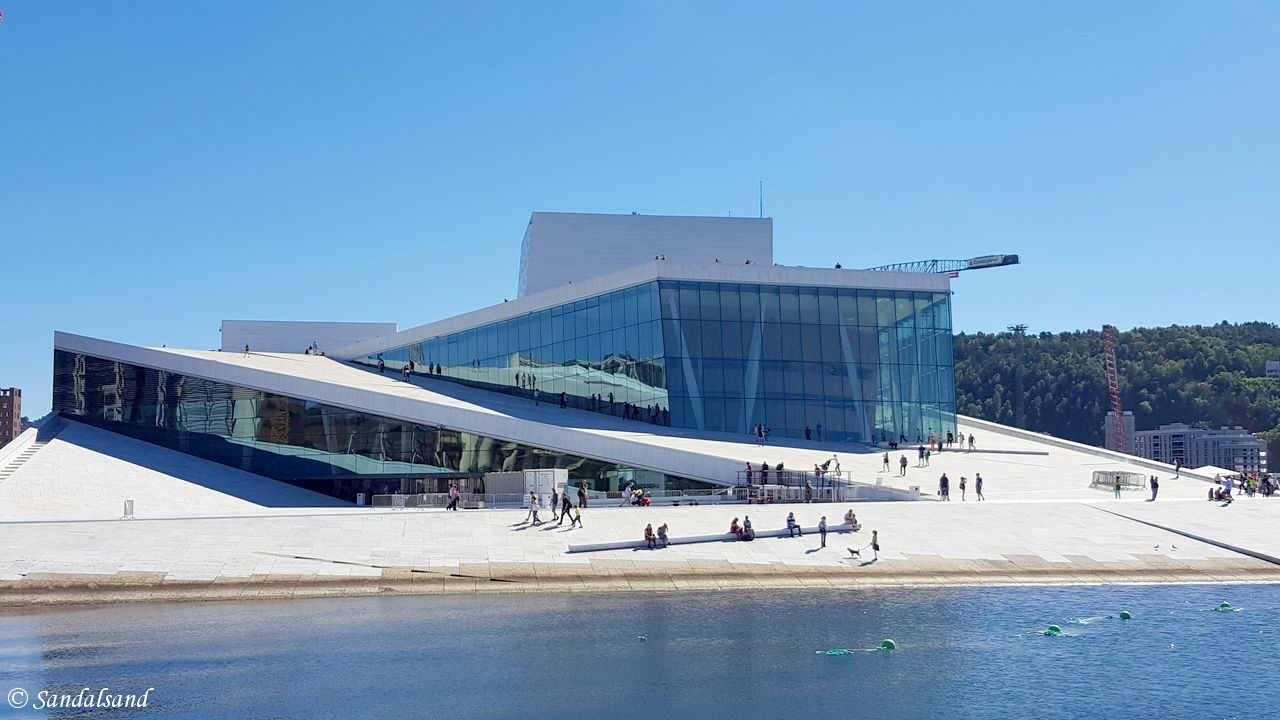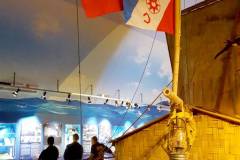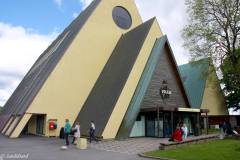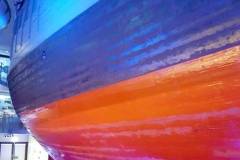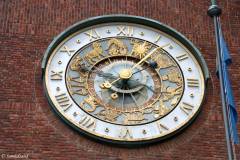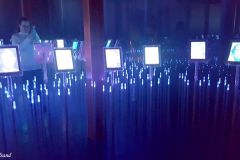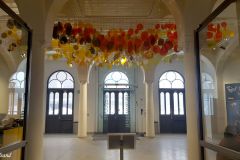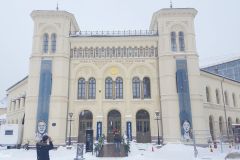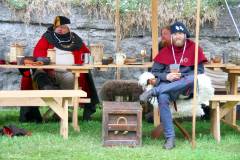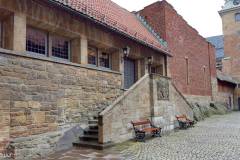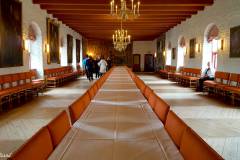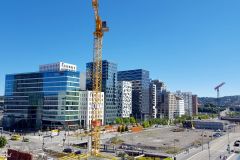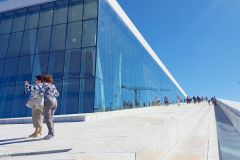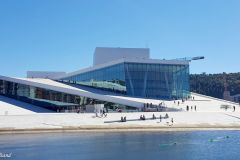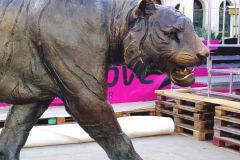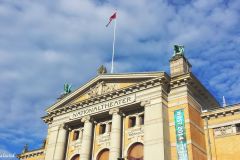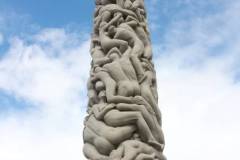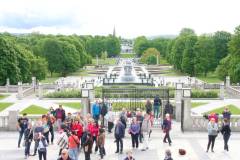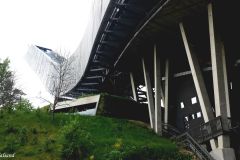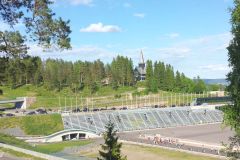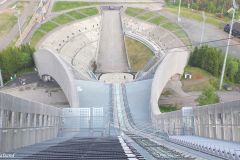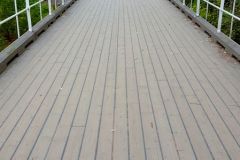Oslo offers a number of sights that will engage you for several days. Find 25 top attractions in Oslo that deserve your attention.
The sights are numbered and you can find them on the map at the bottom of the article. The numbering indicates the order of the visits, not the value.
DENNE ARTIKKELEN ER OGSÅ TILGJENGELIG PÅ NORSK.
(1, 2, 3, 4 and 5) Vikings and other great explorers at Bygdøy
What to see?
We start this expedition just outside the centre of Oslo. The Bygdøy peninsula has a wide selection of museums that will engage you for several hours. If you visit them, you get a good insight into Norway’s history and the people who populate this distant coastal strip in Northern Europe. If you take the bus (or car), the first museum you meet is the Norwegian Museum of Cultural History (Norsk Folkemuseum, number 1 on the map at the bottom of the article). This is a large open-air museum that displays 160 historic buildings from nearly a thousand years back in time. Most of the year, a lot of activities are offered showing life in the countryside and in the city.
Only a few hundred metres away you will reach the Viking Ship Museum (Vikingskipshuset, no. 2). It contains the three most intact Viking ships ever unearthed. The Vikings sailed across the seas to the west and down the mighty rivers to the east, like explorers, warriors and merchants. The ships and the treasures found in them are displayed here, and nowhere else in the world.
Next, there is a collection of three museums on the far end of Bygdøy. The Norwegian Maritime Museum (Norsk Maritimt Museum, no. 3) gives an introduction to the rich Norwegian maritime cultural heritage. Just next door is the Kon-Tiki Museum (no. 4) with the story of Thor Heyerdahl, one of the world’s most famous explorers. In 1947 he crossed the South Pacific on a fleet of balsa trees. Later he built and sailed several reed boats (Ra).
The last museum at Bygdøy is the Fram Museum (no. 5). It consists of two distinctive buildings, showing off ships (Fram and Gjøa) that were used in Norwegian polar expeditions in the Arctic and Antarctica from the end of the 19th century. An example is Roald Amundsen’s expedition to the South Pole. The museums provide a great insight, and interactive experience, of these expeditions to discover and explore the most extreme areas of the world.
Sandalsand has articles in Norwegian from the Norsk Folkemuseum, Vikingskipshuset, Norsk Maritimt Museum, Kon-Tiki, Frammuseet. Use Google Translate to read them in your language.
How to get there?
My suggestion is that you take the regular public bus no. 30 from anywhere in the centre of Oslo and get off at the first museum mentioned. From there you can easily walk to the other museums. From the pier at the Fram museum there is a ferry taking you back into Oslo, on the doorstep of the City Hall. Download the Ruter app to pre-purchase your bus ticket. You should consider buying the Oslo Pass for free admissions to 30 museums and all public transport in Oslo. (Read more in the final section of this article.)
(6) City Hall (Oslo Rådhus)
What to see?
When you visit Oslo you will sooner or later find yourself close to the red-brick monumental structure housing the City Hall (Rådhuset, no. 6 on the map). Since the late 1950’s the twin towers has served as a landmark for everyone coming to Oslo by sea or on land. A large number of tour groups are led inside for a tour of the halls and corridors and more. If you are not interested in that, you may find it rewarding to walk around it and admire the artistic works.
Sandalsand has an article in Norwegian about the artwork around the City Hall.
Right in the centre of Oslo, on the bay.
(7 and 8) The Nobel Peace Center (and soon the National Museum)
What to see?
The Nobel Peace Center (no. 7) is the museum about the Nobel Peace Prize. They present the Peace Prize laureates and their work, and tell the story of Alfred Nobel and the Peace Prize. The centre offers permanent and temporary exhibitions and more in an effort to foster reflection and engagement on topics related to war, peace and conflict resolution.
Right behind it the far larger and modern structure will be housing the National Museum (no. 8). It is due to open in 2020 and will be “the largest art museum in the Nordic region and a venue for entirely new encounters with art.”
Read Sandalsand’s article from the Peace Center.
How to get there?
The Peace centre is located right next to the City Hall, in front of the National Museum and adjacent to the next landmark in this part of Oslo.
(9 and 10) Aker Brygge and the Astrup Fearnley Museum
What to see?
When we walk from the City Hall, past the Peace Center, we’ll encounter the area known as Aker Brygge (no. 9). This is a former ship yard which in the 1980’s was turned into an area of shopping, dining and entertainment. Above the street level there are also flats which makes this a residential area as well. All of this makes Aker Brygge into a lively place to visit all through the year, around the clock. It has in recent years been stretched outwards on land reclamation.
On the last stretch of land fill one will find even more upscale flats and also the Astrup Fearnley Museum of Modern Art (no. 10). It is highly recommended.
Read Sandalsand’s article about the Astrup Fearnley in Norwegian.
How to get there?
Walk from the City Hall. There is no other way.
(11) Beach relaxation on Hovedøya island
What to see?
The island of Hovedøya (no. 11) is one of several islands in the Oslo fjord. If you are in Oslo on warm summer day, join the locals and head for this lush and green island for some hours of relaxation. There are ample opportunities for walking, as well as sandy beaches. There are also historical landmarks like the ruins of a medieval monastery and later military barracks. Hovedøya is however not a destination on a rainy or cold day.
Read Sandalsand’s article from Hovedøya and the special article about the former monastery.
How to get there?
Take one of the (frequent) ferries from the pier outside the City Hall.
(12) Getting that medieval touch at Akershus Castle
What to see?
It is a formidable fortress we encounter, at the far end of Akersneset. Here at Akershus fortress and castle, the armed forces have been around for over 700 years. We find a medieval castle, a renaissance palace and a garrison. Still, the sound from the salute cannons on the ramparts are heard on major holidays, and still the king and government invite their guests to banquets in the palace halls.
Read Sandalsand’s articles from the fortress and the annual Medieval festival.
How to get there?
You walk.
(13 and 14) One more selfie on the slanting roof of the Opera house
What to see?
In a few years, the Opera House (number 13 on the map) in Oslo became a national icon, a building that put the city and the country on the map internationally. In terms of content, it has become a place to meet new experiences and impressions, for a far larger part of the population than what the critics believed in advance. Going to the top of the sloping chalk-white roof has become a must-do for anyone visiting the capital.
From here you also have good views out over the fjord. Furthermore, we notice the series of office buildings and hotels that simply got the name Barcode (14). It is easy to understand why. In this area, in 2020, a new main library (Deichmanske) and not least a spectacular Munch Museum will be opened.
Barcode is best seen from a distance, but you can of course also walk along the row of buildings. If you go far enough you will reach the ruins of Old Oslo, where the city was in the Middle Ages.
Read Sandalsand’s articles about the Operahuset and the Medieval ruins.
How to get there?
Again, you walk.
(15, 16, 17, 18 and 19) Hunt sculptures on the walk from Oslo Central Station to the Royal Palace
What to see?
This is a most unusual piece of advice. Sort of. I have written a couple of articles about artworks one may discover on the walk from the Central Station (Oslo sentralstasjon, no. 12) to the Royal Palace (Det Kongelige Slott, Slottet). In fact, this walk coincides with walking the main artery of Norway, the Karl Johan street.
On my looking for statues, sculptures and the like along this street, I found a large number. On the other side, this is also a way to discover the architecture and buildings in the heart of Oslo. Here we find the little we have of national, monumental institution buildings in the country. The walk passes by the National Assembly (called the Storting) (no. 16), the National Theatre (no. 17), the University (no. 18) and finally the Royal Palace (no. 19).
Read Sandalsand’s two articles from the sculpture walk and start with this one (in English this time). Read also about the Royal Palace (in Norwegian).
How to get there?
The central train and bus station should be easy to find.
(20) Vivid nakedness in the Vigeland sculpture park
What to see?
The Frogner park and the Vigeland park in Oslo is an exquisite parkland that is visited annually by one million people. Most visitors will probably come here because of Gustav Vigeland’s sculpture park, and even for us who have been here a few times before, there is always something new to discover. Join us. The Vigeland Park is located within the larger Frogner Park. The sculpture park contains more than 200 artwork in bronze, granite and cast iron. Famous sculptures include the Sinnataggen, the Monolith and the Life Wheel, but the variety is very large.
This is one of Norway’s largest tourist attractions.
Read Sandalsand’s article about the Vigeland Park.
How to get there?
Trams 12 and 15 stop just outside the main entrance. It is also possible to walk from the metro stop at Majorstuen. If you come from Royal Palace (attraction no. 19) you can retrace your route down to the National Theatre and take the tram 15 or the subway from there. I recommend the tram for the sake of sightseeing.
(21 and 22) Dragons and wild screems at Frognerseteren and the Holmenkollen ski jump arena
What to see?
The view from the tower at Holmenkollbakken (no. 22) is fabulous. Behind us lies the deep forests of Nordmarka, in front is Oslo and the wide fjord. Below is the world’s most spectacular and well-known ski jump. This is Oslo’s foremost tourist attraction, and at the same time one of Norway’s most visited destinations.
I recommend starting further uphill at Frognerseteren (21). This is a facility consisting of several buildings, including a restaurant. The view over the Oslo Fjord on good days is absolutely unique. The restaurant has a menu based on Norwegian traditional food, and the buildings with their characteristic dragon style are also solidly planted in Norwegian history. In any case, when there is no snow around us, it is a nice walk on good hiking trails down to the ski arena in Holmenkollen. There you can get up into the tower and into the Ski Museum.
What about wild screams? Well, try the zipline. It will take you from the top of the ski jump and all the way down to the landing area, just like a ski jumper.
Read Sandalsand’s article about Holmenkollen (English this time).
How to get there?
Take the metro to Frognerseteren, that is, the last stop of Holmenkollbanen. From there it is easy to walk down to the ski arena, and on to the metro stop which is simply called Holmenkollen.
(23) Among bees and flowers in the Oslo Botanical garden
What to see?
It is now 200 years since they started to build a garden in the area around Tøyen Manor. It has become a brilliant adventure centre for both visitors and locals. It’s almost as if the Botanical Garden should be mandatory for anyone to seek out. You get both an urban promenade in a well-kept park, you get a historic rush from the old buildings, and you can learn a lot from reading the small patches that are posted at the beds.
In the area we also find two university museums – the Botanical Museum and the Zoological Museum.
Read Sandalsand’s article about the Botanical garden.
How to get there?
If you are on Holmenkollen Metro stop, you can take the line to Bergkrystallen and get off at Tøyen. The same stop also applies if you start in the city centre. From there it is five minutes to walk.
(24) Hipster watching on Grünerløkka
What to see?
Our next attraction is a short walk downhill from the Botanical Garden. Just east of the Akerselva River we find the area called Grünerløkka. According to the advertising poster VisitOslo, “there are small cafes, restaurants, bars and nightlife. Grünerløkka is also a popular shopping district, with original design shops and many vintage and second-hand stores.” They are right about that.
When you have walked up to the park called Birkelunden, you can turn west until you meet the next and last sight on this journey through Oslo.
How to get there?
Again, your best option is to walk.
(25) Hike along Akerselva, the river that divides east from west
What to see?
Old and blue the Akerselva floats on an almost eight-kilometre long journey from north to south in Oslo. This river separates east from west in the city in more than one sense. Occasionally, the water throws itself down a cliff in one of the many waterfalls. In the 19th century the waterfalls provided the basis for industrial activity and rapid housing development along much of the river. In our time, Akerselva is a glorious recreation area from end to end.
You do not have to walk all 8 km, and it is quite a nice trip to follow the river down from, for example, Aamodt Bru. This is where the cursor with number 25 is located in the map below.
How to get there?
On foot. Electric bikes and kick wheels are also alternatives, of course.
The map
Here it is, Sandalsand’s Oslo map with all numbered attractions marked. Use it on your offline version of Google Maps. I have tried to place the numbered attractions in an order that is practical with regard to public transport and your own feet. Four proposed walking routes are included.
Practical information
VisitOslo is the official tourist information guide to Oslo. Check the website and download their app. They offer the Oslo Pass with these advantages: “The Oslo Pass gives you free entry to 30 museums and attractions, free travel on all public transport, free entry to outdoor swimming pools, free walking tours, discounts on sightseeing, Tusenfryd Amusement Park, concert tickets, climbing, ski rental, and special offers in restaurants, shops, entertainment and leisure venues.”
Ruter is the company running all public transport in and around Oslo. Check the website and download their app. If the Oslo Pass doesn’t suit your needs, you should consider buying their 24 hrs ticket.
Read more on Sandalsand
Look up all articles from Norway and find other European city breaks here, here and here.
The Sandalsand Norge website is in Norwegian which might be considered a lingual obstacle for some. Please have a go with Google Translate and dive into 600 articles, more than 10,000 pictures and almost 60 videos from all corners of the country.

